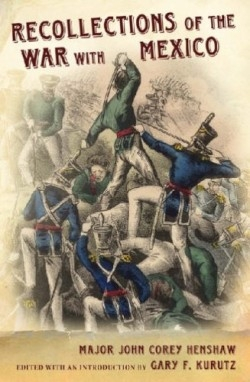Recollections of the War With Mexico
Recollections of the War With Mexico is a unique and intriguing slice of history. Written by Brevet Major John Henshaw (1815—1877) in the mid 1800s, it has been meticulously pieced together from original documents, diary entries, letters, and personal notes, and placed in historical context by editor Gary Kurutz. Because the initial manuscript was essentially one long paragraph loaded with complex passages, quixotic punctuation, marginally legible handwriting, and cross-written sentences (lines written back and forth in opposite directions over each other to save paper), Kurutz had to play detective as well as editor. He’s done a fabulous job of untangling the data, modernizing the grammar, and serving up a fascinating book.
The editor’s introduction is riveting. It helps readers not only understand Henshaw’s character but also the larger historical context within which he wrote. An enigmatic individual who possessed a keen mind but abrasive personality, Major Henshaw was horrified by the sight of blood and determined not to shed a single drop in battle, by no means beneficial attributes for a combat soldier. He faced courts-martial for insubordination several times and was even drummed out of the service for a few years before becoming reinstated at reduced rank and pay.
While clearly an imperfect officer, Henshaw was an exceptional historian—meticulous, insightful, and well-placed to observe and record the action. Most soldiers who wrote about the war with Mexico either died during the fighting or entered into the conflict after it was already underway. Henshaw, on the other hand, was present at almost every major event from start to finish, serving under the war’s two principal generals, Zachary Taylor and Winfield Scott.
Henshaw wrote unabashedly about the bravery of individual soldiers while excoriating the competence of command leadership. He also railed against the depredations of those who overstepped their bounds, killing indiscriminately or taking advantage of the local women. And he described everything from a crimson-colored fly used to dye clothing, to how a mule died of snakebite while its rider recovered, to how he was able to identify potable water by the type of plants that grew near it, to a day-by-day account of the siege of Fort Texas (later renamed Fort Brown).
Gary Kurutz has served as the director of the Special Collections Branch of the California State Library in Sacramento since 1980, and has previously held the positions of library director of the California Historical Society and bibliographer of Western Americana at the Henry E. Huntington Library. A consummate researcher, he includes a fifty-four-item bibliography of rare manuscript collections, government documents, newspapers, periodicals, and other published primary sources that he used to compile his work. Additionally, there are fifty-six secondary sources and forty-seven pages of notes explaining various elements of the text. The end result is a very thorough and well-written tome.
Disclosure: This article is not an endorsement, but a review. The publisher of this book provided free copies of the book to have their book reviewed by a professional reviewer. No fee was paid by the publisher for this review. Foreword Reviews only recommends books that we love. Foreword Magazine, Inc. is disclosing this in accordance with the Federal Trade Commission’s 16 CFR, Part 255.

